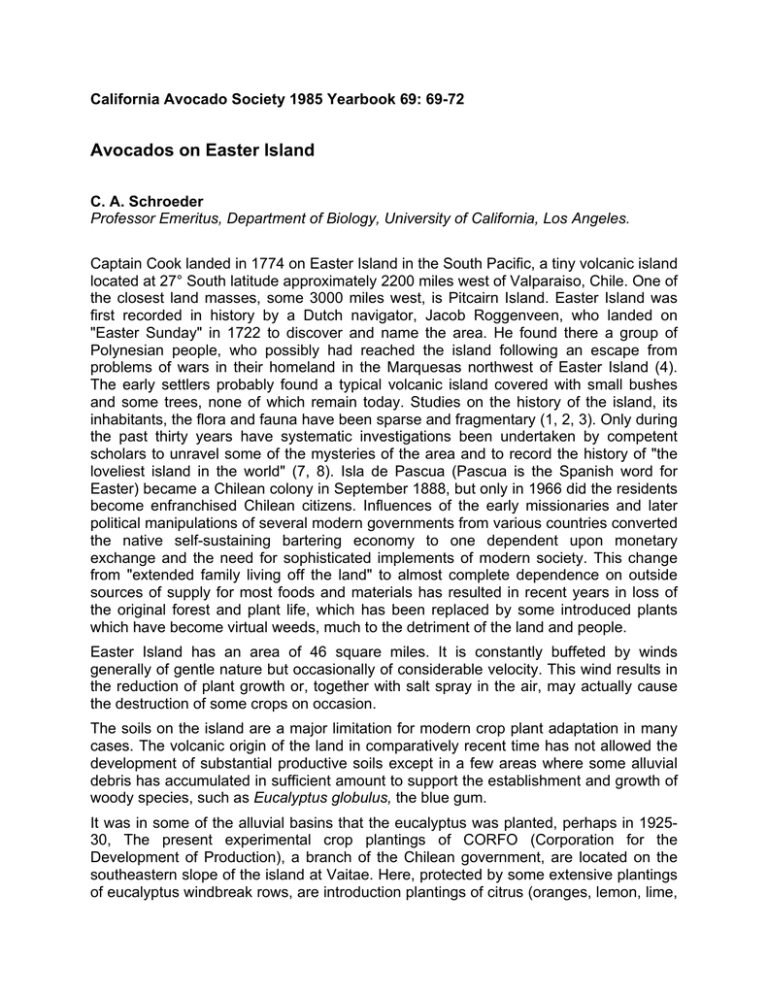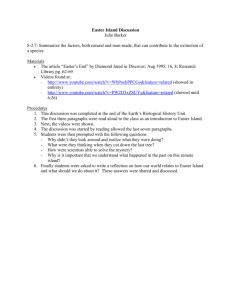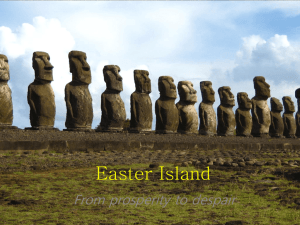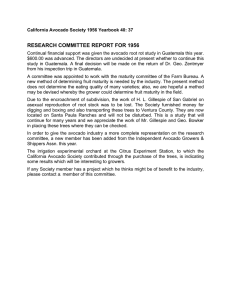Avocados on Easter Island
advertisement

California Avocado Society 1985 Yearbook 69: 69-72 Avocados on Easter Island C. A. Schroeder Professor Emeritus, Department of Biology, University of California, Los Angeles. Captain Cook landed in 1774 on Easter Island in the South Pacific, a tiny volcanic island located at 27° South latitude approximately 2200 miles west of Valparaiso, Chile. One of the closest land masses, some 3000 miles west, is Pitcairn Island. Easter Island was first recorded in history by a Dutch navigator, Jacob Roggenveen, who landed on "Easter Sunday" in 1722 to discover and name the area. He found there a group of Polynesian people, who possibly had reached the island following an escape from problems of wars in their homeland in the Marquesas northwest of Easter Island (4). The early settlers probably found a typical volcanic island covered with small bushes and some trees, none of which remain today. Studies on the history of the island, its inhabitants, the flora and fauna have been sparse and fragmentary (1, 2, 3). Only during the past thirty years have systematic investigations been undertaken by competent scholars to unravel some of the mysteries of the area and to record the history of "the loveliest island in the world" (7, 8). Isla de Pascua (Pascua is the Spanish word for Easter) became a Chilean colony in September 1888, but only in 1966 did the residents become enfranchised Chilean citizens. Influences of the early missionaries and later political manipulations of several modern governments from various countries converted the native self-sustaining bartering economy to one dependent upon monetary exchange and the need for sophisticated implements of modern society. This change from "extended family living off the land" to almost complete dependence on outside sources of supply for most foods and materials has resulted in recent years in loss of the original forest and plant life, which has been replaced by some introduced plants which have become virtual weeds, much to the detriment of the land and people. Easter Island has an area of 46 square miles. It is constantly buffeted by winds generally of gentle nature but occasionally of considerable velocity. This wind results in the reduction of plant growth or, together with salt spray in the air, may actually cause the destruction of some crops on occasion. The soils on the island are a major limitation for modern crop plant adaptation in many cases. The volcanic origin of the land in comparatively recent time has not allowed the development of substantial productive soils except in a few areas where some alluvial debris has accumulated in sufficient amount to support the establishment and growth of woody species, such as Eucalyptus globulus, the blue gum. It was in some of the alluvial basins that the eucalyptus was planted, perhaps in 192530, The present experimental crop plantings of CORFO (Corporation for the Development of Production), a branch of the Chilean government, are located on the southeastern slope of the island at Vaitae. Here, protected by some extensive plantings of eucalyptus windbreak rows, are introduction plantings of citrus (oranges, lemon, lime, grapefruit), avocado (palto), cherimoya, lúcuma (Lúcuma nervosa), per-simon, tropical guava (Psidium guajava), and date palm. Most of these plants were brought from the mainland of Chile during recent years (4). Some of the introductions, especially those protected from the wind, are growing moderately well. Failure to provide adequate moisture probably accounts for the poor growth of most specimens. Many of the orchards are rain-fed, hence receive only irregular amounts of water. The avocado has been grown in Chile since the beginning of historical times. Its early history on the mainland is described by Magdahl (5). The more recent mainland developments were based primarily on varieties introduced from California. Without doubt, some of these Chilean mainland avocados were brought to Easter Island in very recent times. Some of the older avocado trees at Vaitae are seedlings of Mexican and Guatemalan types. Several trees near "the house" are 60-70 feet tall, with trunk diameters at the base from 20-30 inches. A shipment of avocado plants to Isla de Pascua about 1960 included such varieties as Nabal, Fuerte, and Mexicola, (6). It is quite likely that some of the trees near "the house" represent this shipment. Some trees have trunks about 15 to 18 inches in diameter. The bark on most of the trees is generally smooth. One tree has a deeply furrowed bark comparable to that found on black walnut trunks or some rough-barked oak trees. Leaf samples from among the several older trees have strong anise odor or no odor. Walking about the town of Hanga Roa one finds the colorful, small houses of lava stone or concrete hidden among the extensive growth of Melia azedaraeh, bananas, and tropical guava (Psidium guajava) which dominate the roadsides. Each house has some dooryard fruit trees such as papaya, mango, figs, guava, and avocado. All of these dooryard avocado trees (paltos) have been grown from seed. Most of the trees are 10 to 15 feet tall, probably of very recent planting. The trees are highly variable in character and fruiting behavior. Most of the local seedlings appear to be of Guatemalan or Mexican types. A few have good crops of young fruit which will mature in January or February. These are of Mexican type, having a thin, glossy skin, and apparently will produce a rather small fruit. There appears to be no grafting or budding of fruit trees generally except in the case of citrus trees, which are imported from the mainland as budded nursery plants. There is no avocado industry on the island. Occasionally a few avocado fruits (paltas) are offered for sale in the central market or in the few small stores. There is no incentive at this time to produce the avocado for export or general public consumption. Shipping costs by air are prohibitive. Only one ship, or possibly two, stops at the small port during the year. Local demand for avocado is limited except for a few instances of local consumption by island visitors or by a few government employees who can afford to buy much of their foods of mostly imported sources. Most of the local people obtain their personal supply of avocados from the "dooryard tree." There are no records of avocado production on the island. Casual observations suggest that many trees in more favorable localities bear good crops of potential commercial value. There are no marketing facilities for the fruit other than an occasional box or basket of palta which appears in the local family store. It is altogether possible that some changes in the island economy within the near future could affect the development of the avocado as a crop plant if appropriate incentives could be developed. This generality could be applied to a number of other crops such as citrus, guava, papaya, and mango which grow well in the wind-protected areas. Perhaps with the potential increase in tourism and the need for attractive fresh fruits on the menu for the tourist, the avocado could fulfill an economic niche on Easter Island. Literature Cited 1. Agassiz, A. 1906. Reports on the scientific results of the expedition to the eastern tropical Pacific. Mus. Comp. Zool. Harvard College Mem. 33: 53-62. 2. Elinne, M., G. Michea, and E. Diaz. 1982. Flora, vegetation y potential pastoral de Isla de Pascua. Fac. de Cien. Aprarias Vet. y Forestal, Univ. de Chile. 3. Fuentes, F. 1911. Resena botánica sobre da Isla de Pascua. Inst. Central Meteorológica de Chile 4: 1-9. 4. Heyerdahl, T., et al. 1961. Archeology of Easter Island. Stockholm. 1538 p. 5. Magdahl, R. A. 1958- Report from Chile. Calif. Avocado Soc. Yearbook42: 44-50. 6. Rosenberg, G. 1983. Professor of Horticulture, University of Santiago (personal communication). 7. Shottsberg, G. 1917. The phanerogams of Easter Island. In: Natural History of Juan Fernandez and Easter Island. Uppsala (Ed. Carl Shottsberg), Vol. 2: 61-84, 487502. 8. Sudzuki, Fusa. 1979. Vegetation arbórea y erosion en la Isla de Pascua. Fac. de Agron., Univ. of Chile, Santiago,





